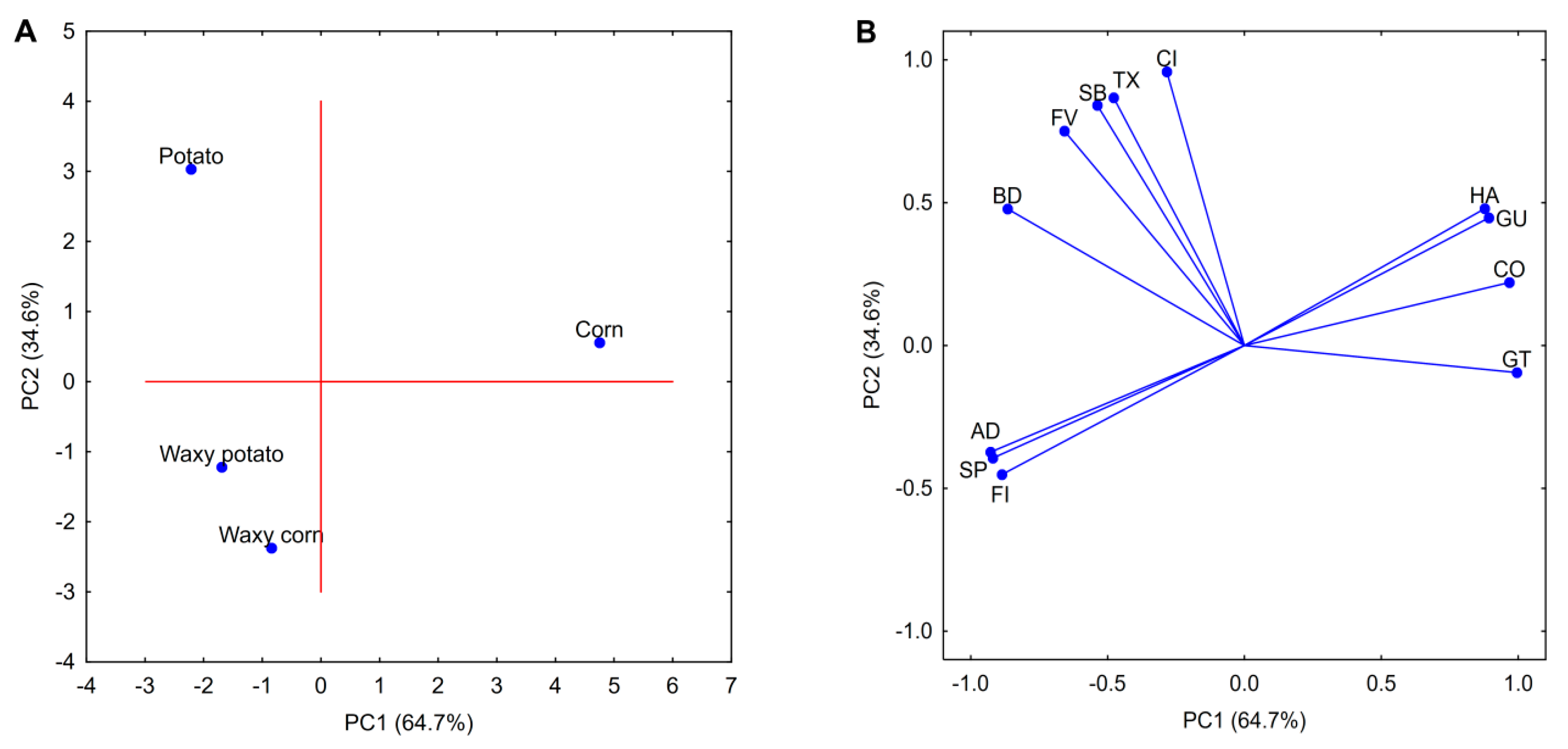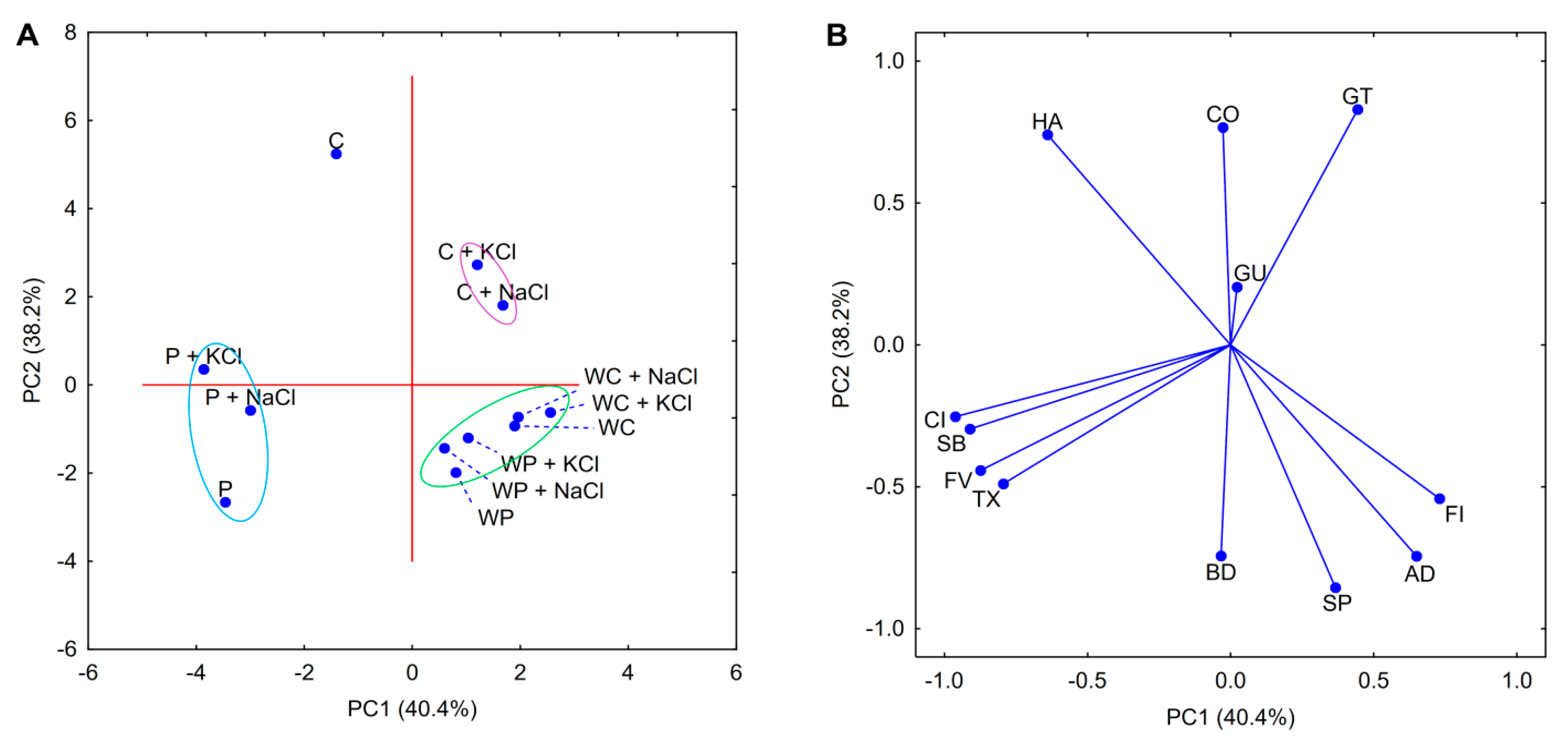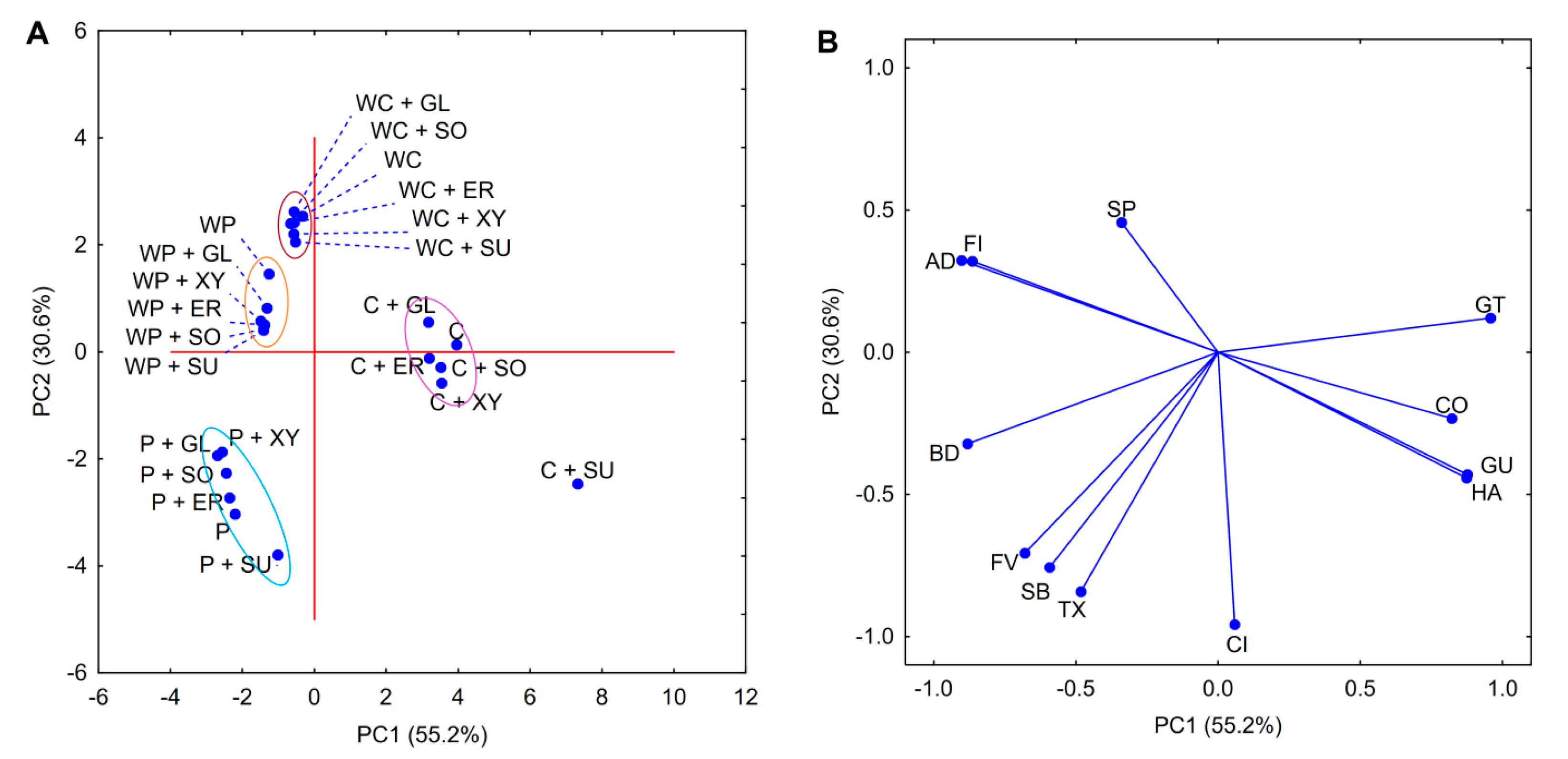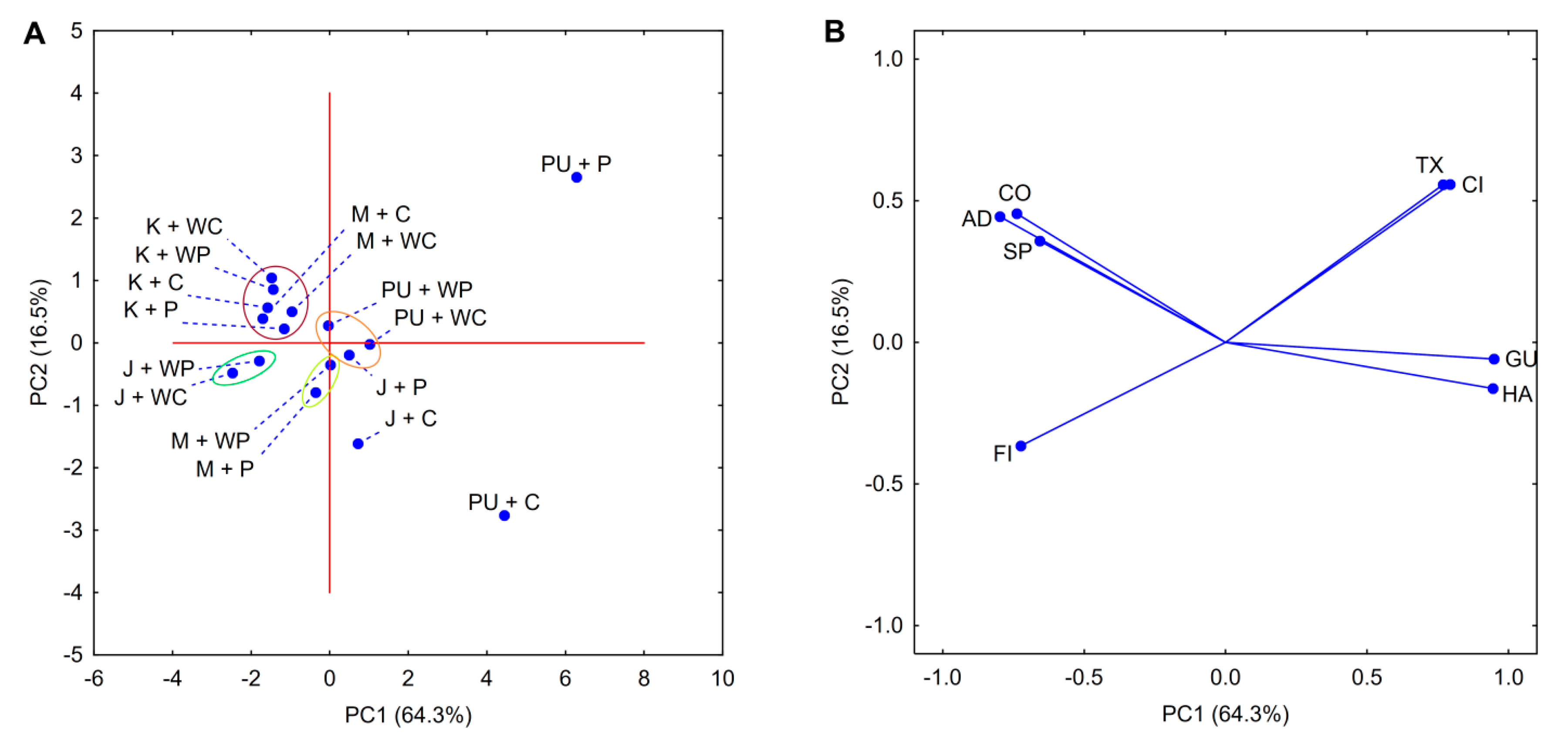Functionality of Native Starches in Food Systems: Cluster Analysis Grouping of Rheological Properties in Different Product Matrices
Abstract
1. Introduction
2. Materials and Methods
2.1. Starch
2.2. Preparation of Starch Binary Mixtures
2.3. Preparation of Model Food Systems
- Ketchup: 60 g tomato paste (30 ± 2% dry matter), 25 g sucrose, 12 g vinegar (10%), 6.5 g starch, 3 g salt, 0.2 g finely milled black pepper, water up to 200 g.
- Mayonnaise (low fat): 125 g water, 120 g rapeseed oil, 17 g sucrose, 14 g starch, 10 g vinegar (10%), 10 g dried egg yolk, 6 g mustard, 3 g salt.
- Pudding: 20 g sucrose, 18 g starch, 250 g milk (3.8% fat).
- Jelly: 20 g starch, 12.5 g sucrose, 1 g citric acid, water up to 250 g.
- Ketchup: All ingredients, excluding vinegar, were mixed with an overhead stirrer (R50D, Ingenieurburo CAT M. Zipperer GmbH, Germany) operating at 150 rpm. Raw ketchup samples were placed in a boiling water bath for 15 min. Vinegar and evaporated water were added at the last stage of ketchup preparation. Prepared samples were stored for 24 h at 4 °C prior to analysis [40].
- Mayonnaise: Prior to the preparation of the emulsion, a starch suspension was pasted along with water, sugar, and salt. The emulsion was ground in a semicircular bowl (9 cm radius) with a twin shaft mixer (400 W). Oil was added gradually (during 1 min) to avoid phase separation. Vinegar and mustard were added at the last stage of mayonnaise preparation. Ready mayonnaise was mixed for an additional 1 min. Further analyses were made on products stored for 24 h at 4 °C [41].
- Pudding: Starch was suspended in 50 mL of cold milk and poured into boiling milk (mixed with sucrose). Afterward, the pudding was mixed with an overhead stirrer (R50D, CAT) operating at 150 rpm and boiled for an additional 5 min. Prepared samples were allowed to set at room temperature for 1 h prior to the analysis [42].
- Jelly: All ingredients were mixed together with an overhead stirrer (R50D, CAT) operating at 150 rpm and placed in a boiling water bath for 15 min. Prepared samples were allowed to set at room temperature for 1 h prior to the analysis [42].
2.4. Determination of Pasting Characteristics
2.5. Determination of Rheological Properties
2.6. Determination of Universal Texture Profile
2.7. Statistical Analysis
3. Results and Discussion
3.1. Starch Pastes
3.2. Binary Mixtures
3.2.1. Salts
3.2.2. Sucrose and Polyols
3.3. Food Products
4. Conclusions
Supplementary Materials
Author Contributions
Funding
Conflicts of Interest
References
- Waterschoot, J.; Gomand, S.V.; Fierens, E.; Delcour, J.A. Production, structure, physicochemical and functional properties of maize, cassava, wheat, potato and rice starches. Starch-Stärke 2015, 67, 14–29. [Google Scholar] [CrossRef]
- Ashogbon, A.O.; Akintayo, E.T. Recent trend in the physical and chemical modification of starches from different botanical sources: A review. Starch-Stärke 2014, 66, 41–57. [Google Scholar] [CrossRef]
- Walkowiak, K.; Masewicz, Ł.; Kowalczewski, P.; Baranowska, H.M. Susceptibility of normal and waxy starches to microwave treatment. In Proceedings of the 15th International Conference on Polysaccharides-Glycoscience, Prague, Czech Republic, 13–15 November 2019; Řápková, R., Hinková, A., Čopíková, J., Šárka, E., Eds.; Czech Chemical Society: Prague, Czech Republic, 2019; pp. 18–22. [Google Scholar]
- Szwengiel, A.; Kowalczewski, P.Ł.; Wielich, F.; Małyszek, Z.; Le Thanh-Blicharz, J.; Lewandowicz, G. Changes in the rheological properties and structure of potato starch upon hydrothermal treatment. In Proceedings of the 15th International Conference on Polysaccharides-Glycoscience, Prague, Czech Republic, 13–15 November 2019; Řápková, R., Hinková, A., Čopíková, J., Šárka, E., Eds.; Czech Chemical Society: Prague, Czech Republic, 2019; pp. 37–41. [Google Scholar]
- Le Thanh-Blicharz, J.; Anioła, J.; Kowalczewski, P.; Przygoński, K.; Zaborowska, Z.; Lewandowicz, G. Type IV resistant starch increases cecum short chain fatty acids level in rats. Acta Biochim. Pol. 2014, 61, 109–114. [Google Scholar] [CrossRef] [PubMed]
- FAO. Compendium of Food Additive Specifications; FAO JECFA Monographs: Geneva, Switzerland, 2018. [Google Scholar]
- Asioli, D.; Aschemann-Witzel, J.; Caputo, V.; Vecchio, R.; Annunziata, A.; Næs, T.; Varela, P. Making sense of the “clean label” trends: A review of consumer food choice behavior and discussion of industry implications. Food Res. Int. 2017, 99, 58–71. [Google Scholar] [CrossRef]
- Ai, Y.; Jane, J. Gelatinization and rheological properties of starch. Starch-Stärke 2015, 67, 213–224. [Google Scholar] [CrossRef]
- Juszczak, L.; Witczak, M.; Ziêba, T.; Fortuna, T. Rheological behaviour of heated potato starch dispersions. Int. Agrophysics 2012, 26, 381–386. [Google Scholar] [CrossRef]
- Dobosz, A.; Sikora, M.; Krystyjan, M.; Tomasik, P.; Lach, R.; Borczak, B.; Berski, W.; Lukasiewicz, M. Short- and long-term retrogradation of potato starches with varying amylose content. J. Sci. Food Agric. 2019, 99, 2393–2403. [Google Scholar] [CrossRef]
- Byars, J.A.; Singh, M. Rheological and textural properties of pulse starch gels. Starch-Stärke 2016, 68, 778–784. [Google Scholar] [CrossRef]
- Siroha, A.K.; Punía, S.; Sandhu, K.S.; Karwasra, B.L. Physicochemical, pasting, and rheological properties of pearl millet starches from different cultivars and their relations. Acta Aliment. 2020, 49, 49–59. [Google Scholar] [CrossRef]
- Abdel-Aal, E.M.; Rabalski, I.; Hernandez, M.; L’Hocine, L.; Patterson, C.A.; Hucl, P. Effect of sodium chloride, sucrose, and xanthan gum on pasting properties and gel syneresis of hairless canary seed starch. Cereal Chem. 2019, 96, 908–919. [Google Scholar] [CrossRef]
- He, X.; Xia, W.; Chen, R.; Dai, T.; Luo, S.; Chen, J.; Liu, C. A new pre-gelatinized starch preparing by gelatinization and spray drying of rice starch with hydrocolloids. Carbohydr. Polym. 2020, 229, 115485. [Google Scholar] [CrossRef]
- Varela, M.S.; Navarro, A.S.; Yamul, D.K. Effect of hydrocolloids on the properties of wheat/potato starch mixtures. Starch-Stärke 2016, 68, 753–761. [Google Scholar] [CrossRef]
- Zhuang, H.; Feng, T.; BeMiller, J.N. Effect of hydrocolloids on waxy maize starch and its distarch phosphates. Food Hydrocoll. 2020, 100, 105325. [Google Scholar] [CrossRef]
- Shrivastava, M.; Yadav, R.B.; Yadav, B.S.; Dangi, N. Effect of incorporation of hydrocolloids on the physicochemical, pasting and rheological properties of colocasia starch. J. Food Meas. Charact. 2018, 12, 1177–1185. [Google Scholar] [CrossRef]
- Juszczak, L.; Witczak, M.; Fortuna, T.; Banachowicz, A. Effect of Some Hydrocolloids on the Rheological Properties of Rye Starch. Food Sci. Technol. Int. 2004, 10, 125–131. [Google Scholar] [CrossRef]
- Dobosz, A.; Sikora, M.; Krystyjan, M.; Lach, R.; Borczak, B. Influence of xanthan gum on the short- and long-term retrogradation of potato starches of various amylose content. Food Hydrocoll. 2020, 102, 105618. [Google Scholar] [CrossRef]
- Sikora, M.; Krystyjan, M.; Dobosz, A.; Tomasik, P.; Walkowiak, K.; Masewicz, Ł.; Kowalczewski, P.Ł.; Baranowska, H.M. Molecular Analysis of Retrogradation of Corn Starches. Polymers 2019, 11, 1764. [Google Scholar] [CrossRef]
- Sikora, M.; Kowalski, S.; Tomasik, P. Binary hydrocolloids from starches and xanthan gum. Food Hydrocoll. 2008, 22, 943–952. [Google Scholar] [CrossRef]
- Zhang, Y.; Li, M.; You, X.; Fang, F.; Li, B. Impacts of guar and xanthan gums on pasting and gel properties of high-amylose corn starches. Int. J. Biol. Macromol. 2020, 146, 1060–1068. [Google Scholar] [CrossRef]
- Ye, J.; Yang, R.; Liu, C.; Luo, S.; Chen, J.; Hu, X.; Wu, J. Improvement in freeze-thaw stability of rice starch gel by inulin and its mechanism. Food Chem. 2018, 268, 324–333. [Google Scholar] [CrossRef]
- Luo, D.; Li, Y.; Xu, B.; Ren, G.; Li, P.; Li, X.; Han, S.; Liu, J. Effects of inulin with different degree of polymerization on gelatinization and retrogradation of wheat starch. Food Chem. 2017, 229, 35–43. [Google Scholar] [CrossRef] [PubMed]
- Chen, L.; Tian, Y.; Tong, Q.; Zhang, Z.; Jin, Z. Effect of pullulan on the water distribution, microstructure and textural properties of rice starch gels during cold storage. Food Chem. 2017, 214, 702–709. [Google Scholar] [CrossRef] [PubMed]
- Chen, L.; Tong, Q.; Ren, F.; Zhu, G. Pasting and rheological properties of rice starch as affected by pullulan. Int. J. Biol. Macromol. 2014, 66, 325–331. [Google Scholar] [CrossRef] [PubMed]
- Gałkowska, D.; Długosz, M.; Juszczak, L. Effect of high methoxy pectin and sucrose on pasting, rheological, and textural properties of modified starch systems. Starch-Stärke 2013, 65, 499–508. [Google Scholar] [CrossRef]
- Dangi, N.; Yadav, B.S.; Yadav, R.B. Pectin and its acid hydrolysate for the modification of hydration, pasting, thermal and rheological properties of barley starch. Int. J. Biol. Macromol. 2020, 152, 969–980. [Google Scholar] [CrossRef]
- Wu, M.; Wang, J.; Ge, Q.; Yu, H.; Xiong, Y.L. Rheology and microstructure of myofibrillar protein–starch composite gels: Comparison of native and modified starches. Int. J. Biol. Macromol. 2018, 118, 988–996. [Google Scholar] [CrossRef]
- Gałkowska, D.; Juszczak, L. Effects of amino acids on gelatinization, pasting and rheological properties of modified potato starches. Food Hydrocoll. 2019, 92, 143–154. [Google Scholar] [CrossRef]
- Nicol, T.W.J.; Isobe, N.; Clark, J.H.; Matubayasi, N.; Shimizu, S. The mechanism of salt effects on starch gelatinization from a statistical thermodynamic perspective. Food Hydrocoll. 2019, 87, 593–601. [Google Scholar] [CrossRef]
- Hedayati, S.; Majzoobi, M.; Shahidi, F.; Koocheki, A.; Farahnaky, A. Effects of NaCl and CaCl2 on physicochemical properties of pregelatinized and granular cold-water swelling corn starches. Food Chem. 2016, 213, 602–608. [Google Scholar] [CrossRef]
- Zhang, F.; Liu, M.; Mo, F.; Zhang, M.; Zheng, J. Effects of acid and salt solutions on the pasting, rheology and texture of lotus root starch-konjac glucomannan mixture. Polymers 2017, 9, 695. [Google Scholar] [CrossRef]
- Owczarz, P.; Orczykowska, M.; Rył, A.; Ziółkowski, P. The effects of sucrose on the sol-gel phase transition and viscoelastic properties of potato starch solutions. Food Chem. 2019, 271, 94–101. [Google Scholar] [CrossRef]
- Zolelmein, A.; Movahhed, S.; Azizi, M.H.; Ahmadi Chenarbon, H. Assessment of simultaneous addition of sucrose and xanthan effects on the thermal, pasting, and rheological behavior of corn starch. J. Texture Stud. 2020, 51, 453–463. [Google Scholar] [CrossRef] [PubMed]
- Mohamed, A.A.; Alamri, M.S.; Hussain, S.; Ibraheem, M.A.; Qasem, A.A. Rheological properties of sweet potato starch-date syrup gel. Food Sci. Technol. 2019, 39, 1030–1039. [Google Scholar] [CrossRef]
- Sun, Q.; Dai, L.; Nan, C.; Ji, N.; Xiong, L. Effects of heat moisture treatment with erythritol on the physicochemical properties of wheat starch. Starch-Stärke 2014, 66, 496–501. [Google Scholar] [CrossRef]
- Martínez, M.M.; Pico, J.; Gómez, M. Effect of different polyols on wheat and maize starches paste and gel properties. Food Hydrocoll. 2015, 44, 81–85. [Google Scholar] [CrossRef]
- Mohamed, I.O.; Babucurr, J. Pasting, rheological, and retrogradation properties of low-amylose rice starch with date syrup. Food Sci. Technol. Int. 2017, 23, 550–558. [Google Scholar] [CrossRef] [PubMed]
- Śmigielska, H.; Lewandowicz, J.; Le Thanh-Blicharz, J. Effect of type 4 resistant starch on colour and rheological properties of tomato ketchup. Zywn. Nauka. Technol. Jakosc/Food Sci. Technol. Qual. 2013, 20, 137–149. [Google Scholar] [CrossRef]
- Lewandowicz, J.; Le Thanh-Blicharz, J. Quality of reduced fat mayonnaise prepared with native waxy starches. In Proceedings of the 14th International Conference on Polysaccharides-Glycoscience, Prague, Czech Republic, 7–9 November 2018; Rapkova, R., Hinkova, A., Copikova, J., Sarka, E., Eds.; Czech Chemical Society: Prague, Czech Republic, 2018; pp. 262–265. [Google Scholar]
- Lewandowicz, G.; Wronkowska, M.; Sadowska, J.; Soral-Śmietana, M.; Błaszczak, W.; Walkowski, A. Influence of potato starch oxidation on texture and rheological behaviour of some sweet desserts. Pol. J. Food Nutr. Sci. 2003, 2, 31–36. [Google Scholar]
- Lewandowicz, J.; Baranowska, H.M.; Szwengiel, A.; Le Thanh-Blicharz, J. Molecular structure vs. Functional properties of waxy and normal corn starch. In Proceedings of the 12th International Conference on Polysaccharides-Glycoscience, Prague, Czech Republic, 19–21 October 2016; Rapkova, R., Copikova, J., Sarka, E., Eds.; Czech Chemical Society: Prague, Czech Republic, 2016; pp. 53–57. [Google Scholar]
- Park, E.Y.; Kim, H.N.; Kim, J.Y.; Lim, S.T. Pasting properties of potato starch and waxy maize starch mixtures. Starch-Stärke 2009, 61, 352–357. [Google Scholar] [CrossRef]
- Sánchez, T.; Dufour, D.; Moreno, I.X.; Ceballos, H. Comparison of pasting and gel stabilities of waxy and normal starches from potato, maize, and rice with those of a novel waxy cassava starch under thermal, chemical, and mechanical stress. J. Agric. Food Chem. 2010, 58, 5093–5099. [Google Scholar] [CrossRef]
- Le Thanh-Blicharz, J.; Lubiewski, Z.; Voelkel, E.; Lewandowicz, G. Ocena właściwości reologicznych handlowych skrobi naturalnych. Żywn. Nauk. Technol. Jakość 2011, 18, 53–65. [Google Scholar]
- Doublier, J.-L. Rheological Studies on Starch—Flow Behaviour of Wheat Starch Pastes. Starch-Stärke 1981, 33, 415–420. [Google Scholar] [CrossRef]
- Härröd, M. Modelling of flow properties of starch pastes prepared by different procedures. J. Food Process Eng. 1989, 11, 257–275. [Google Scholar] [CrossRef]
- Gambuś, H.; Gumul, D.; Juszczak, L. Rheological Properties of Pastes Obtained from Starches Derived from Immature Cereal Kernels. Starch-Stärke 2004, 56, 225–231. [Google Scholar] [CrossRef]
- Carrillo-Larco, R.; Saavedra-Garcia, L.; Miranda, J.; Sacksteder, K.; Diez-Canseco, F.; Gilman, R.; Bernabe-Ortiz, A. Sodium and Potassium Consumption in a Semi-Urban Area in Peru: Evaluation of a Population-Based 24-Hour Urine Collection. Nutrients 2018, 10, 245. [Google Scholar] [CrossRef]
- Haque, M.; McKimm, J.; Sartelli, M.; Samad, N.; Haque, S.Z.; Bakar, M.A. A narrative review of the effects of sugar-sweetened beverages on human health: A key global health issue. J. Popul. Ther. Clin. Pharmacol. 2020, 27, e76–e103. [Google Scholar] [CrossRef]
- Zhang, Y.; Cremer, P. Interactions between macromolecules and ions: The Hofmeister series. Curr. Opin. Chem. Biol. 2006, 10, 658–663. [Google Scholar] [CrossRef]
- Evageliou, V. Effect of sucrose, glucose and fructose on gelation of oxidised starch. Carbohydr. Polym. 2000, 42, 261–272. [Google Scholar] [CrossRef]
- Oosten, B.J. Effects of Organic Molecules on the Gelatinization Temperature of Starch. Starch-Stärke 1984, 36, 18–23. [Google Scholar] [CrossRef]
- Lii, C.-Y.; Lai, V.M.-F.; Liu, K.-F.; Chang, W.-H. Influences of Polyols on Thermal and Dynamic Viscoelastic Properties of Rice Starches during Gelatinization. Starch-Stärke 1997, 49, 346–354. [Google Scholar] [CrossRef]








| Starch | Potato | Waxy Potato | Corn | Waxy Corn |
|---|---|---|---|---|
| Gelatinization temperature (°C) | 62.0 ± 0.1 | 64.8 ± 0.1 | 84.5 ± 0.1 | 68.7 ± 0.1 |
| Final viscosity (BU) | 1133 ± 24 | 612 ± 15 | 296 ± 10 | 348 ± 9 |
| Breakdown (BU) | 1319 ± 30 | 888 ± 8 | 6 ± 1 | 422 ± 7 |
| Setback (BU) | 621 ± 20 | 233 ± 10 | 149 ± 7 a | 140 ± 10 a |
| Consistency index (Pa∙sn) | 31.86 ± 0.98 | 10.93 ± 0.60 ab | 16.71 ± 5.09 b | 5.47 ± 0.36 a |
| Flow behavior index (-) | 0.468 ± 0.001 a | 0.495 ± 0.006 a | 0.356 ± 0.044 | 0.508 ± 0.006 a |
| Thixotropy (Pa∙s−1) | 49,535 ± 2496 | 10054 ± 547 a | 7208 ± 3298 a | 5503 ± 839 a |
| Hardness (N) | 0.42 ± 0.03 a | 0.35 ± 0.00 a | 0.57 ± 0.07 | 0.34 ± 0.00 a |
| Adhesiveness (N∙s) | −0.21 ± 0.06 | 0.00 ± 0.01 a | −0.92 ± 0.13 | 0.00 ± 0.00 a |
| Cohesiveness (-) | 0.74 ± 0.01 a | 0.73 ± 0.00 a | 0.78 ± 0.04 a | 0.74 ± 0.00 a |
| Springiness (-) | 0.99 ± 0.01 a | 1.00 ± 0.00 a | 0.96 ± 0.04 a | 1.00 ± 0.00 a |
| Gumminess (N) | 0.31 ± 0.02 a | 0.26 ± 0.00 a | 0.44 ± 0.07 | 0.25 ± 0.00 a |
© 2020 by the authors. Licensee MDPI, Basel, Switzerland. This article is an open access article distributed under the terms and conditions of the Creative Commons Attribution (CC BY) license (http://creativecommons.org/licenses/by/4.0/).
Share and Cite
Le Thanh-Blicharz, J.; Lewandowicz, J. Functionality of Native Starches in Food Systems: Cluster Analysis Grouping of Rheological Properties in Different Product Matrices. Foods 2020, 9, 1073. https://doi.org/10.3390/foods9081073
Le Thanh-Blicharz J, Lewandowicz J. Functionality of Native Starches in Food Systems: Cluster Analysis Grouping of Rheological Properties in Different Product Matrices. Foods. 2020; 9(8):1073. https://doi.org/10.3390/foods9081073
Chicago/Turabian StyleLe Thanh-Blicharz, Joanna, and Jacek Lewandowicz. 2020. "Functionality of Native Starches in Food Systems: Cluster Analysis Grouping of Rheological Properties in Different Product Matrices" Foods 9, no. 8: 1073. https://doi.org/10.3390/foods9081073
APA StyleLe Thanh-Blicharz, J., & Lewandowicz, J. (2020). Functionality of Native Starches in Food Systems: Cluster Analysis Grouping of Rheological Properties in Different Product Matrices. Foods, 9(8), 1073. https://doi.org/10.3390/foods9081073






